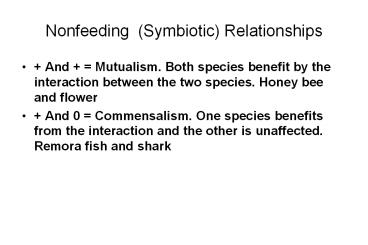Nonfeeding (Symbiotic) Relationships - PowerPoint PPT Presentation
1 / 15
Title:
Nonfeeding (Symbiotic) Relationships
Description:
Nonfeeding (Symbiotic) Relationships + And + = Mutualism. Both species benefit by the interaction between the two species. Honey bee and flower – PowerPoint PPT presentation
Number of Views:215
Avg rating:3.0/5.0
Title: Nonfeeding (Symbiotic) Relationships
1
Nonfeeding (Symbiotic) Relationships
- And Mutualism. Both species benefit by the
interaction between the two species. Honey bee
and flower - And 0 Commensalism. One species benefits from
the interaction and the other is unaffected.
Remora fish and shark
2
Nonfeeding (Symbiotic) Relationships
- And - One species benefits from the
interaction and the other is adversely affected.
Examples are predation, parasitism, and disease. - - And - Competition. Both species are adversely
affected by the interaction.
3
Resource Partitioning Reducing Competition
4
Abiotic Factors
- Law of Limiting Factors Every species (both
plant and animal) has an optimum range, zones of
stress, and limits of tolerance with respect to
every biotic factor.
5
Survival Curves Illustrate Law of Limiting Factors
6
Application of the Law of Limiting Factors
- Compare the tolerance differences for a trout
and a catfish using water - temperature (cold or warm).
- oxygen concentration (high or low).
- salinity (high or low).
7
Oxygen Tolerance Curves for Two Different Fish
Species
Diagram the temperature tolerance curves for each
fish species.
8
From Ecosystems to Global Biomes
- The role of climate
- Microclimate and other abiotic factors
- Biotic factors
- Physical barriers
9
Climate and Major Biomes
10
Identify Biomes A to E Based on Temperature and
Precipitation Levels Answers Next Slide
Precipitation
11
Answers to Previous Slide
- A has high temperature and low moisture hot
desert - B has low temperature and low moisture cold
desert (tundra with permafrost) - C has medium temperatures and moisture
grassland - D has high temperature and moisture rain forest
- E has low temperature and high precipitation
arctic poles
12
Effects of Latitude and Altitude
13
Microclimates
14
The Human Presence
- Three revolutions
- Neolithic
- Industrial
- Environmental
- Red Sky in the Morning by James Gustave
- The Inconvenient Truth by Al Gore
15
How Humans Modify Their Physical Environments to
Meet Their Needs
- Produce abundant food
- Control water flow rate and direction
- Overcome predation and disease
- Construct our own ecosystems
- Overcome competition with other species































